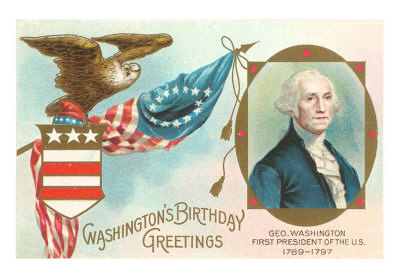
Images of Liberty and Power
[Updated June 12, 2011]
Washington's Birthday or Presidents Day: The Hagiography of Presidential Power.
 |
 |
John James Barralet, "The Apotheosis of Washington" (1802-1816) [See a larger version of the image as an engraved print for more details]. |
Unknown, "The Apotheosis of Washington
and Lincoln" (1865) |
Introduction
The first president of the United States, George Washington, was born on February 22, 1732 and died on December 14, 1799.
The third Monday of February is designated "Presidents Day" in the United States. It was first proclaimed quite late in the history of the republic (1880) and therefore was not part of the evolution of the office of the presidency in its first hundred years. In fact, the founding fathers would probably have been horrified at the thought of paying hommage in this way to a single man or even the office of the presidency when more abstract notions of "liberty" and the "rule of law" were still so highly regarded. Celebrating the man would have smacked too much of the idea of kingship which they had fought so hard against in the 1770s and 1780s. There had been some talk of making the highest political office in America an "elected monarchy" but even a wealthy, slave owning, ex-general like George Washington baulked at the idea.
Thomas Paine (see this quote of the week on Paine's idea that only "the law was king" in America) had to persaude some of his contemporaries in 1776 (in Common Sense) that if they thought it a "deficiency" not to have a King in an independent America then they might prefer to think that their "King" was the rule of law and the "Charter" or constitution which embodied the law. In these passages Paine worries about a newly independent America reverting to a monarchy. Paine thought an agitator like Massanello might prey on discontent to take over the government and declare himself king. Thomas Jefferson, in a letter to Robert Livingston (December 1800), worried in a similar fashion that republicanism in America was only skin deep and that there lurked a monarchie masquée (hidden monarchy) just below the surface. Furthermore Paine thought, if a day of celebration were to be set aside then homage should be paid to the law (the “Charter”), a crown set upon it to remind those gathered that “the law is king”, and at the end of the ceremony the crown should be smashed and scattered among the people as a reminder that the notion of kingship is a dangerous thing in a free republic. One wonders what he or Jefferson would think of the modern celebration of the man and the office known as "Presidents Day".
To return to the origin of "Presidents Day" (or Washington's Birthday as it was originally known), it was first proclaimed in 1880 as a holiday for federal workers only in the District of Columbia (thus it was a holiday to enable federal government workers to have a paid day not to work). It was extended to workers in all federal offices across the nation in 1885. It was the first federal holiday to celebrate a single individual (Washington) and it fell on George Washington's actual birthday February 22, 1732 (although his birthday was in fact February 11 under the old Julian calendar - but the new Gregorian calendar had been introduced across the British Empire in 1752 and so according to this revised calendar his new birthday was now February 22). [See the Wikipedia entry on Washington's Birthday <http://en.wikipedia.org/wiki/Presidents_day>].
In 1951 during the early years of the Cold War a group began agitating for Congress to establish a "Presidents Day" to honour all the presidents as well as the office of the presidency itself, no doubt in an effort to emphasize the role of the office of the Presidency in the American republic in contrast to the recently defeated Il Duce of fascist Itlay and the Führer of Nazi Germany, as well as the powerful "Secretaries" or "Chairmen" of the communist parties of the Soviet Union and China. February was seen as an appropriate month because both Washington and Lincoln had their birthdays then (Lincoln on February 12) and both were regarded as crucial "fathers of the nation" - Washington for leading the military at the founding of the nation and Lincoln for using the military to forcibly maintain the union of the states in the face of seccession. Legislation in 1968 retained the name "Washington's Birthday" for the public holiday but in popular parlance it has become known as "Presidents Day". The establishment of the day as part of a more encompassing "Uniform Monday Holiday Act" ((1971) is just one more example of how far reaching government regulation has gone in America where the Congress can now "legislate" time itself and tell citizens when to get up, when to go to work, when to go to bed and when to take a day off, with public holidays and day light saving.
Additional Reading:
- George Washington
- School of Thought: The Founding Fathers
- Topic: The American Revolution and the Constitution
The Hagiography of Political Power
I have termed the process of glorification and near-worship of political leaders like Washington "hagiography" (after the centuries old Catholic tradition of creating saints out of ordinary men and women) but there are other terms which might also be used: "apotheosis" or "deification" - the elevation of someone to divine status; "regification" (my own term) - the elvation of someone to the status of a king or monarch. The latter, as noted above, was a fear held by Thomas Jefferson as early as 1800 when he worried about an underlying monarchie masquée within the American republic. There have been occasions in the past when the monarchie masquée has risen to the surface. During the Civil War in the 1860s, during the Great Depression and fascist era of the 1930s, and during the beginnning of the Cold War in the 1950s. The common theme which emerges is that in times of war, economic hardship, and militarization governments seek greater legitimacy for their actions by glorifying the leader in a variety of ways, such as putting their faces on stamps, coins, and bank notes; celebrating their birthdays with national holidays, building monumental statues of their likeness, encouraging the circulation to a mass audience of postcards with suitably uplifting images, and so on.
The Great Leader's Face on Paper Money and Stamps
For millenia it was the custom to have the face or head of the emperor or king on coins. It was in this way that the likeness of the great leader could be seen by as many people as possible across the territory ruled by the monarch. It was a striking fact of the American and then the French revolutions that this custom was broken as the king's head was replaced by symbols of the new republican regime such as "liberty" or political mottoes which embodied the principles of the revolution. A good example is some of the first coins issued by the American revolutionaries which had abstract images of liberty, american eagles, laurel wreaths, star bursts but not actual individuals who had fought in the revolution. Below are four coins from the colonial and early republican period:
- a Continental Dollar from 1776 which depicts a sun dial and a burst of sunlight on the obverse, with the slogan "Mind Your Business". On the reverse side is a series of 13 interlocking circles with the names of the 13 colonies resisting the British Empire.
- a "NovaConstellatio" (or "new Constellation" coin from 1783 with 13 new stars represnting the 13 rebellious colonies on the obverse, and a seated Liberty holding the scales on justice in her left hand and a staff with phrygian can in her right hand.
- a Libertas Half Cent coiin from 1793 with the head of Liberty on the obverse side, and a wreath and the "United States of America" written on the reverse side.
- a Liberty Silver Dollar from 1804 with the head of Liberty and 13 stars representing the 13 new states of the union on the obverse, and an American eagle clutching arrows in one claw and an olive branch in the other, with the motto "e pluribus unum" and 13 stars on the reverse.
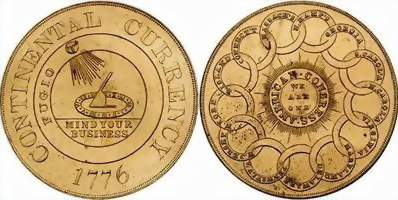 |
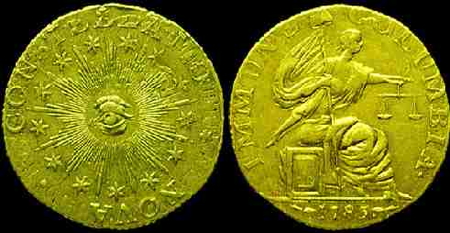 |
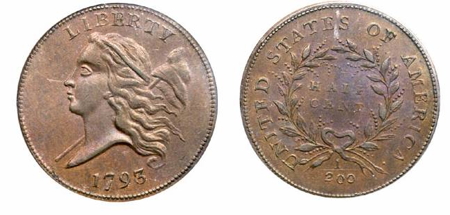 |
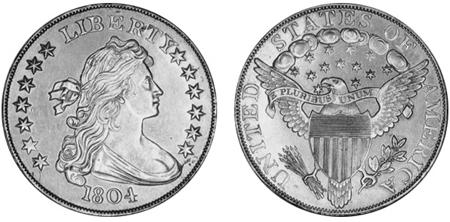 |
[Source: a variety of non-copyright web sites.]
So, it is interesting to ask oneself when images of specific political leaders first began go appear on American currency (and stamps) and why this occured after an an initial strong refusal to do so by the founding fathers. According to the Wikipedia article on the US One Dollar Bill the first one dollar bill was issued during the Civil War in 1862 featuring the image of Salmon P. Chase, the Secretary of the Treasury. In the same year a two dollar bill was issued with the image of Alexander Hamilton (who would have been pleased as he supported the idea of a national bank) which was followed in 1869 with another design of a two dollar bill with the image of Thomas Jefferson (who would not have been pleased as he strenuously opposed any institution such as a national bank). Also in 1869 the one dollar bill was redesigned with a picture of George Washington in the centre and that of Christopher Columbus sighting land to the left. Strangley, in 1886 the image of Martha Washington appeared on the one dollar "silver certificate" note. She is the only woman to have appeared on a US currency note and only the second (after lady liberty) to have appeared on any form of currency. Martha Washington's appearance on this note might mark the beginning of the cult of the "first lady" in American politics. Ten years later a one dollar bill appeared with both Martha and George Washington depicted on the obverse, the first time both an ex-president and his wife graced the national currency with their likeness. Beow there are images of:
- an 1869 one dollar bill with a picture of Washington in the center and Christopher Columbus to the left
- an 1886 one dollar bill with the image of Martha Washington
- an 1896 one dollar bill with the image of both Martha and George Waswhington on the reverse side
- an 1896 one dollar bill showing the obverse side with the image of "History Instructing Youth" and the Washington Monument and the US Capitol Building visible in the background; to the right is an open copy of the US constitution, and around the perimeter are the names of famous Americans includiing 8 presidents (and Washington).
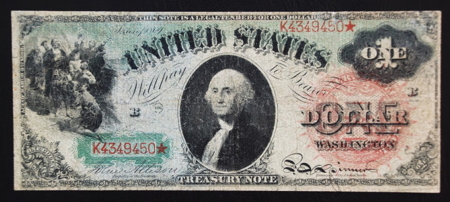 |
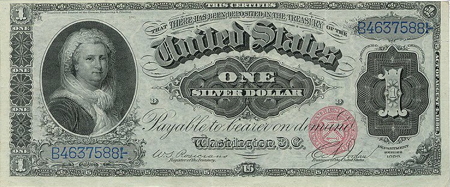 |
 |
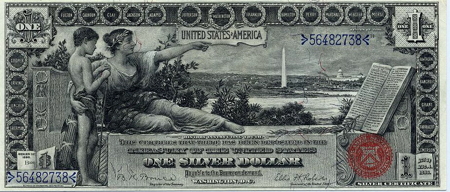 |
[Source: Wikipedia and a variety of non-copyright web sites.]
The 1896 one dollar bill is especially interesting as it was part of a series of beautifully engraved bills called the "Educational Series". There were three in this series: "History Instructing Youth ($1), "Science presents Steam and Electricity to Commerce and Manufacture" ($2), and "Electricity as the Dominant Force in the World" ($5). The 5 dollar bill caused controversy because it depicted lady liberty topless in the French style and this was not well received in conservative Bostonian circles at the time. Martha and George Washington's likesnesses appeared on the reverse side of the one dollar bill. This is how Wikipedia describes the scenes on the obverse side <http://en.wikipedia.org/wiki/Educational_Series>:
The Goddess History instructing a youth, pointing to a panoramic vista view of the Potomac River and Washington D.C. The Washington Monument and the US Capitol Building are visible in the background. The United States Constitution is displayed to the right. Circling the motif are the last names of famous Americans. Some of those listed are: (George) Washington, (Benjamin) Franklin, (Thomas) Jefferson, (Robert) Fulton, (Samuel F.B.) Morse, (Ulysses S.) Grant, Henry Wadsworth Longfellow, William T. Sherman, James Fennimore Cooper, Abraham Lincoln, John C. Calhoun, Washington Irving, Henry Clay, Andrew Jackson, John Adams, Alexander Hamilton, Oliver H. Perry, John Marshall, Daniel Webster, Nathaniel Hawthorne, George Bancroft, David G. Farragut, and Ralph Waldo Emerson.
[See a larger version of the obverse side of the bill for more detail].
Thus eight former presidents are mentioned by name as well as the Washington Monument and the Capitol Building (which will be discussed below as its ceiling fresco contains a detailed painting explicitly called "The Apotheosis of Washington" by Brumidi), all on the one note which must be a world record until the new "Green Card" for resident aliens was issued in 2010 with micro-pictures of dozens of American presidents, incuding George Washington.
An image of George Washington appeared on one of the first stamps issued by the US Postal Service in 1847 along with Benjamin Franklin. George Washington's image has appeared on more American stamps than any other president and for the first 22 years of issuing stamps the US Postal service used images of the presidents exclusively (with the notable exception of Franklin). It seems the American stamps were modeled on the British "Penny Black" stamp which appeared in 1840 with the image of Queen Victoria. This was a revolutionary idea as it was self-adhesive, pre-paid, and independent of the distance the letter travelled, but also quite traditional as it kept the image of the monarch on the stamp.
Below are images of the British 'Penny black" (with Queen Victoria's head), a 3 cent stamp issued in 1851 and a 10 cent stamp issued in 1861 during the Civil War (both with Washington's head).
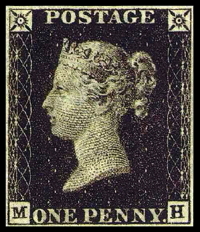 |
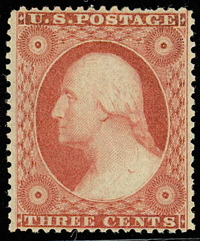 |
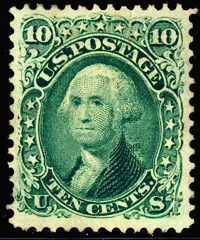 |
[Source: Wikipedia and a variety of non-copyright web sites.]
The Apotheosis of George Washington
There appear to be two main periods for the creation of images of Washington ascending into heaven as a god. The first comes immediately after his death in 1799 and the second comes after the assassination of Abraham Lincoln (April 1865) who is also depicted ascending into heaven as a god but is also welcomed by Washington who has already arrived there. He welcomes him as one ex-president and ex-military leader to another. The parallels to Christian art depicting the assumption of Mary are of course striking. Here is Titian's painting of the "Assumption of the Virgin Mary" (1516) for purposes of comparison:
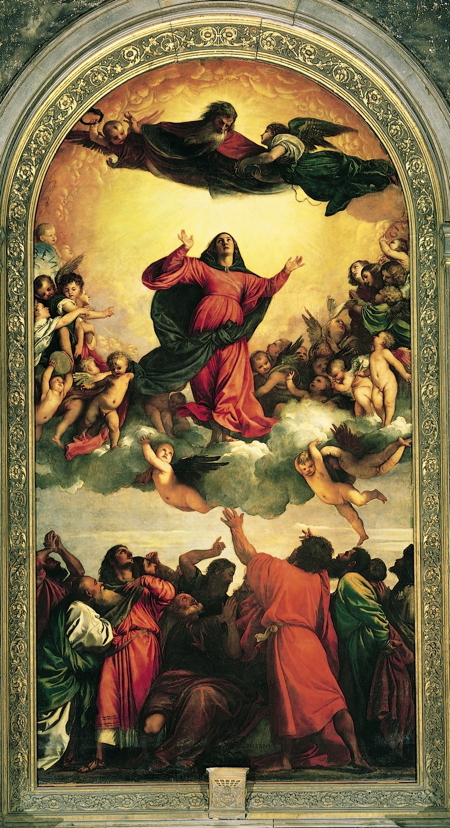 |
[Source: Wikipedia and a variety of non-copyright web sites.]
David Edwin, "Apotheosis of Washington" (1800)
The engraving below by David Edwin is called "Apotheosis of Washington" (1800) and shows Washington, dressed in his burial shroud and clothes, sitting on clouds above Mount Vernon. An angel (or Cupid) is laying a laurel wreath on his head in an effort to bestow immortality upon him. To the right two men are standing suspended in the clouds gesturing to Washington perhaps in welcome to heaven. They are Richard Montgomery and Joseph Warren who were both major generals in the Continental Army during the Revolution and who were killed in battle in 1775.
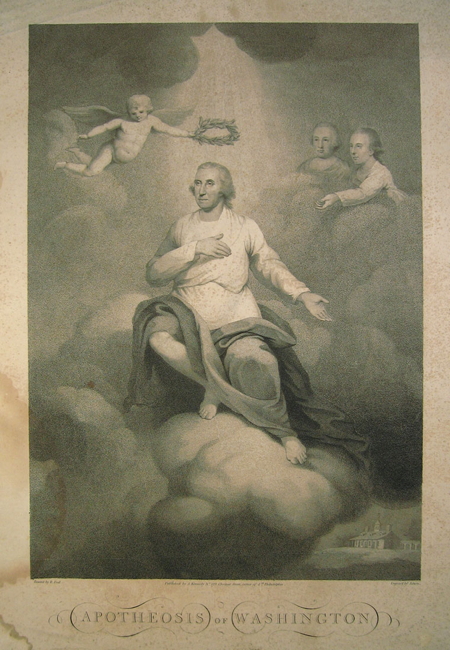 |
David Edwin, "Apotheosis of Washington" (1800) [See a larger version of the image for more details]. |
[Source: the C.W. McAlpin Collection at the New York Public Library <http://legacy.www.nypl.org/research/chss/spe/art/print/exhibits/revolution/selection7.html> and the National Portrait Gallery, Smithsonian Institution].
John James Barralet, "The Apotheosis of Washington" or "The Commemoration of Washington" (1802-1816)
An image which first appeared in 1802 and was reproduced in many forms (including prints and painted glass) has the title "The Apotheosis of Washington" or "The Commemoration of Washington" (as it first appeared in February 1802 when Washington would have turned 70). It shows George Washington ascending into heaven assisted by Father Time and an angel (or "Immortality"). Shafts of light shine down from heaven through a break in the clouds as the angel and Father Time lift Washington, wrapped in a red piece of cloth or perhaps his burial shroud, from what appears to be his coffin or crypt. To the left three women (Faith, Hope, and Charity) can be seen: one holds her hand out towards him grieving; another holds two children in her arms; and a third is slumped forward on her arms weeping. Beneath Washington can be seen an American eagle, the American shield on which is written "e pluribus unum" and Liberty, whose head is bowed in sorrow. Her staff with the red phrygian cap is resting among Washington's discarded armour and sword which lie beside a facses. In the far right bottom corner we can see a American Indian with his hatchet and arrows sitting with his head resting on his knees. On the tomb is written the words "Sacred is the Memory of Washington OB 11 Dec. - D 1799. Et. 68".
 |
John James Barralet, "The Apotheosis of Washington" or "The
Commemoration of Washington" (1802-1816) [See a larger version of the image as an engraved print for more details]. |
[Sources: photograph of a painting on glass held by the Library of Congress; engraving and etching held by the New York Public Library <http://legacy.www.nypl.org/research/chss/spe/art/print/exhibits/revolution/selection7.html>].
Unknown, "The Apotheosis of Washington and Lincoln" (1865)
The next example was a popular postcard which was produced in considerable numbers after the assassination of President Abraham Lincoln in 1865. It depicts Lincoln ascending into heaven. He is dressed in black robes as is George Washington who is embracing him in welcome and is about to place a laurel wreath upon Lincoln's head. Angels are beckoning him to ascend towards the light which streams from the top left of tthe image.
 |
[Sources: a variety of non-copyright web sites and the Library of Congress].
Constantino Brumidi, "The Apotheosis of George Washington" (1865), Capitol Building, Washington, D.C.
During the year after the assassination of Lincoln a monumental work was undertaken by Constantino Brumidi (1805-1880) to depict the apotheosis of George Washington on the ceiling of the recently completed new dome of the Capitol Building in Washington D.C. It is strange to think that expensive construction such as the dome was being undertaken during the Civil War. Brumidi had emigrated from Italy following the 1848 revolution and took American citizenship. In Italy he had done work for the Vatican and while living in New York he made a name for himself doing religious paintings such as the Crucifixion of Christ, the Martyrdom of St. Stephen, and the Assumption of Mary. The fresco he did for the rotunda of the Capitol dome covers an area of some 4,664 square feet and includes a large central piece showing the apotheosis of George Washington surrounded by six allegorical pieces showing aspects of American life and culture - "War," "Science," "Marine," "Commerce," "Mechanics," and "Agriculture". The following is a description of this work:
Washington has become godlike (if not a god) and has ascended into heaven. He sits on a cloud wearing a military jacket in purple (the traditional colour worn by the Roman emperor) and his legs are wrapped in a sheet (also purple). In his left hand he holds a sword and his right hand is gesturing to a book (possibly the constitution of the US). At his left sits Victory draped in a green sheet and wearing a laurel wreath, holding a branch and blowing a turmpet. To Washington's right sits Liberty. She is wearing a red phrygian cap and holds the book to which Washington is gesturing in her left hand; in her right hand she is holding the Roman fasces. [See the detail below].
 |
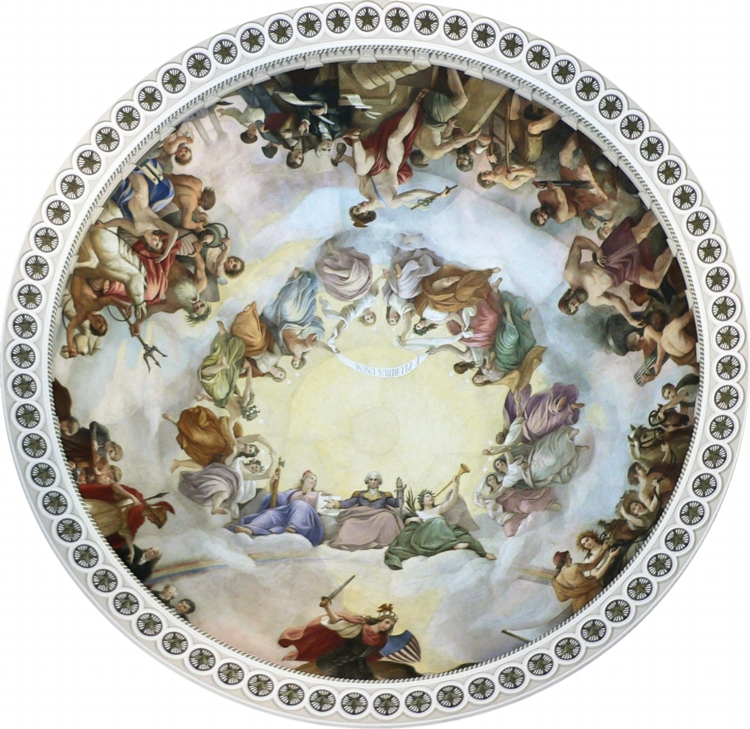 |
Constantino Brumidi, "The Apotheosis of George
Washington" (1865) Capitol Building, Washington, D.C. [See a larger version of this image] |
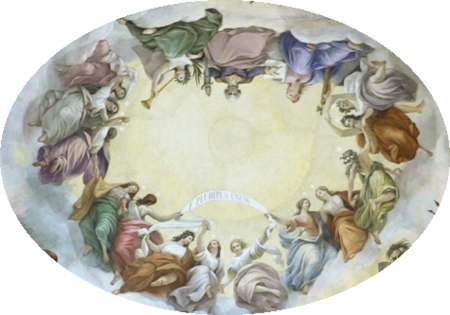 |
Surrounding Washington, Victory, and Liberty in a circle are 13 maidens who represent the original 13 colonies which formed the federation of the United States. Some of them are holding a banner which says "E Puribus Unum" but others have their backs turned towards Washington to indicate those states which attempted to break away from the union during the Civil War. Around the perimeter of the fresco are 6 large pieces which show in allegorical form various aspects of American life and culture. Immediately under Washington, the commander-in-chief of the victorious Continental Army which defeated the British Empire is of course "War", followed in clockwise order by "Science," "Marine," "Commerce," "Mechanics," and "Agriculture." Below is a detail of the allegory of "War":
"Liberty" (or "Columbia") is seen in the more aggressive pose of a warrior brandishing a sword in her right hand and carrying a a shield with the stars and stripes in her left hand. At her left side is an equally aggressive American eagle with mouth open and talons clutching a sheaf of arrows. Beneath them are their defeated enemies who are hard to identify but are most likely an assortment of tyrants, kings, and oppressors who are very fearful of Liberty and her eagle. The woman at the left has her hands outstretched in a pose of submission; the white bearded man next to her is clutching a cannon; the dark bearded man in the center is attired in a uniform of boots, breastplate armor, and helmet, and appears to have a club or weapon in his left hand; the person next to him is wearing a brown cloak and is holding a burning torch in his or her right and left hands; the final figure to the right is holding their hand to their face in a look of bewilderment at the power of Liberty.
 |
[Sources: Wikipedia article on "The Apotheoisis of Washington" http://en.wikipedia.org/wiki/The_Apotheosis_of_Washington> and The Architect of the Capitol website <http://www.aoc.gov/index.cfm>].
Among the many striking things about Brumidi's fresco are the following: the monumental physical scale of the painting, the fact that it was given such prominence in the expanded and rebuilt US Capitol Building, that it was completed at considerable cost during wartime, the clear religious iconography used by Brumidi as he had done previously in explicitly religious paintings in Italy and in New York, the fact that this was not the first occasion when artists depicted the assumption to heaven of Washington and suggested he had god-like powers (the first was immediately after Washington's death in 1799), and the links made between the military leader Washington who defeated the British to "forge" a nation" and the acts of Lincoln in using military force to "preserve the union".
Early 20th Century Political Kitsch
In the second half of the 19th century as a result of innovations in printing technology the price of producing images such as lithographs or postcards dropped dramatically, thus making it feasible to create a market for cheap, mass produced imagery. One topic for postcards which was much liked by consumers were picturesque pictures of popular travel destinations; another were pictures of much admired political leaders such as George Washington and Abraham Lincoln in America and Otto von Bismarck in the German Empire. Many of these were kitsch as the following "Washington's Birthday Greeting Cards" from about 1909 show. They are crudely drawn and sentimental depictions of apocryphal events in Washington's life (such as his admiting to cutting down a cherry tree) or show standard patriotic images of flags and eagles. There is no reference here to his military exploits or his assumption into heaven.
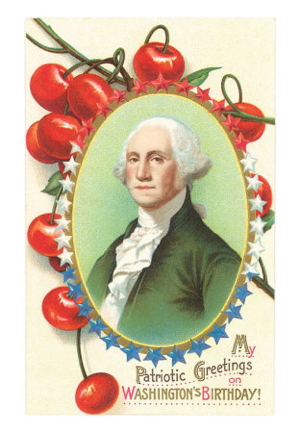 |
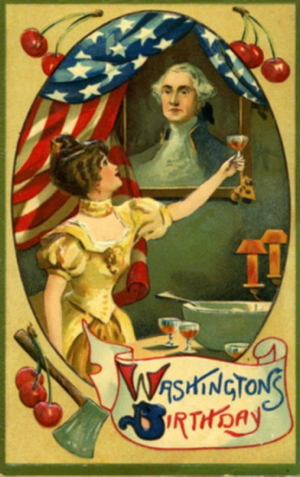 |
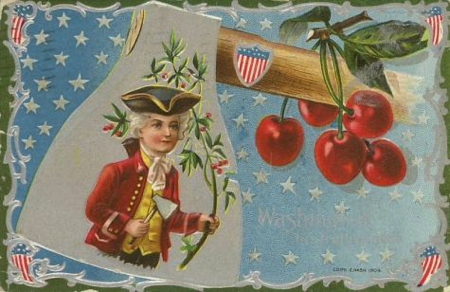 |
|
[Sources: a variety of non-copyright web sites].
